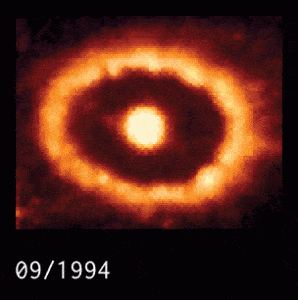Einstein’s theories suggest that light can not travel faster than c, a constant equal to the speed of light in a vacuum, which is 299,792,458 metres per second (by definition) or about 186,282.4 miles per second. All of our standing physical models are based on this assumption, and so far this idea has yet to be proven wrong, despite the neutrino incident from CERN which was later found to be false (at some time neutrinos were found to travel slightly faster than photos, but this was later proven to be due an error in measuring). A study of a 25-year old supernova may lead to a revision of “c”, if its findings are found to be correct. As you might imagine, the implications are huge since the speed of light in vacuum is used as a constant in all astronomical calculations and observations.
Slower light
SN 1987A was first observed in February, 1987 when it baffled some scientists with an intriguing anomaly. After a star collapses, traditionally a super nova should immediately emit a burst of neutrinos, followed by a time delayed burst of photons. In the case of SN 1987, this time delay it greater than it should have been as the optical light arrived roughly 7.7 hours after the neutrinos, or 4.7 hours late instead of the expected 3 hours delay.
Why this differences? Three scenarios have been proposed: the optical photons traveled slower than c, they were emitted later than expected, or they originated from a totally separate and irrelevant event. Typically the last scenario has been used to explain this phenomenon, but James Franson and colleagues at the University of Maryland claim they have found evidence that suggests that light doesn’t actually travel at c in a vacuum – a startling hypothesis which if found true will pose great implications for physics and astrophysics in particular.
When traveling through a medium like water or air, light gets slowed down because it meets all sorts of matter particles. In the case of the vacuum of space, Franson says a natural property of photons themselves, called “vacuum polarization,” causes a slow down. This causes the photon to split into an electron-positron pair that later recombines back to form a photon. Even if this split lasts for a moment, though, theory says that this phenomenon causes a gravitational potential between the two particle states.
The effect and final energy impact of this gravitational potential is so tiny that it only slightly affects the value of c, which is why it has been so difficult to notice it. The 1987 supernova presented an opportunity to accurately time photons as they travel 168,000 light-years to reach us, and the study suggests that the gravitational potential could easily lead to the observed delay of 4.7 hours.
The findings are no less controversial and to accurately confirm such a hypothesis you’d need some serious gear. Super-quick neutrino detectors would help shed light on this, tracking neutrinos back to their source. It’s not only about the gear either – you’d need to study at least a couple of dozen super novae to gather data of the required statistical significance to prove or disprove the paper. As almost always the case, scientists will have to wait many, many years until anything of the sorts can be done.
The paper appeared in the New Journal of Physics.










